
We pick up the story from the 1955-85 era web page after Floyd Clymer (who died in 1970) and his lawyer held the trade names and marks for use on their English and Italian made Indians (culminating in the stillborn Ducati Indiana prototype of 1975), the rights were licensed to a Taiwanese company to make mini-bikes. After some initial success production ceased and by the 1980's the trade mark had sort of gotten lost in the sense that many different people, mostly one-man restoration businesses, were using the mark. In a sense it had fallen into the public domain and there was no legal thread to follow. By the early 1990's with the heavyweight cruiser and touring market booming, several parties began disputing ownership of the names and logos. These legal battles took place in the USA and Canada. Some con-men and even the Cow Creek band of Umpqua Tribe aboriginals of Oregon claimed legal title (the first time Indians had gotten involved with Indian motorcycles.) At least three parties (the native Indians group plus two con men named Philip Zhangi and Wayne Baughman) smoked up "pipe dreams" of a new Chief, but these motorcycles never got beyond the prototype stage.
First photos show some of the IMMI Chiefs made in 1994. The photos below (courtesy of Canadian Biker and Classic Bike magazine) include a wooden mockup of the engine! Cynics called it "The Wooden Indian" and they were right!. I do like the look of the frame and fenders though (compare very wide rear fender on 1999-2003 Chief) and the rear chain was on the "correct" side. The other photos are later in time than the wooden mockup and are of real, running machines.

Viewer Jim Gallagher provided the following info on the 3 running Chiefs that were made. [Thanks, Jim.]
Although the engines are not refined, they did look good in person. Made about 75 HP. (torque about 100 ft. lbs. Between 2000 rpm and redline) They were prototype engines and gearboxes, so had their share of issues. But the exhaust note of the engine in the red bike @ 6,200 RPM sounded much like a small block Chevy sprint car engine ... quite a song !
OTHER SPECS:
Engine: Liquid cooled. 1657 cc's. Ignition : Dual Ignition Coils - Coil on
plug design (mounted in the cylinder head) - as on a 2000 Chevy Trail Blazer
Piston Bore : Big Block Chevy, I think the stroke was a little shorter though
Torque - about 55ft lbs from idle, 85 @ 1750 RPM, to about a peak of 107 ft
lbs (@ 6500 rpm?)
Gearbox - 4 speed
Clutch - Wet Clutch
Frame - 4130 Chromemoly
Weight - 755 lbs dry [about the same as other current big V-twins, so these
Chiefs aren't as heavy as their engines make them look]
Fuel : sequential port fuel injection (same basic system that powered Toyota
to the IMSA GTP Championship)
The suspension was basically a derivative design, using technology from the
suspension designers at Penske Racing (front shocks and springs) and the rear
mono shock was based on an old Norton racing bike.

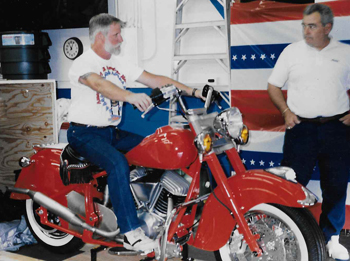
One reader told me the fellow on the bike was the designer, from Albuquerque NM. Nice looking bike.
Next two images are of the Eller corporation's mockup of a Chief. (This was the group funded by the native Americans.) This is not a prototype motorcycle, just a mockup, probably made of plastic, wood, fiberglass etc. Goofy forks are reminiscent of the ill-fated Excelsior-Henderson. Having the alternator where the old generator sprocket and pulley drive used to go is a great idea. Note the attempts to make the engine look like an old side-valved Chief even though OHC was intended. Sharp almost 90 degree edge of fenders is unlike old Indians which were C shaped. Too Harley-ish.
|
|

|
Meanwhile the California Motorcycle Company with a long and good reputation for
building imitation Harley-Davidson Evolution (TM reg.) type engines (but of
larger displacement) and a Toronto Canada clothing and fashion company who'd
been selling Indian logo's T-shirts etc., along with some other wealthy
contenders to the intellectual property, formed a consortium and put their money
($30M to be exact) together and went into legal battle against the other
claimants. A Colorado court appointed a receiver who decided the name and logo
(intellectual property rights) should go to the group that had not just the most
money but also the best prospects of making a real motorycle soon. Clearly the
California-Canadian group had the money and had been building reliable engines
and other components for years, so they won the legal battle. While some folks
still argue the issue, the courts made it clear who is the "real" Indian
motorcycle maker. The amalgamated group called itself Indian Motorcycle
Corporation and produced a Chief in 1999. In 2000 a Scout model was addeed and
in 2001 a Spirit was added to the line. In 2002 the Chief got a new engine
(bigger, looking a lot less like a Harley Evo, and with the carb on the left
side like and old Indian)and a primary case that looked a bit more like an old
Chief and less like a current Harley big twin. In 2003 a Vintage version of the
Chief was added, which looked more like the original 1950-53 Chiefs (perversely
though the fork shrouds were removed - duh!). However although every year the
company sold a much larger number of bikes than the previous year, such that
impressive growth existed, and even within the first six months Chief sales
eclipsed the Polaris Victory (another wholly USA owned and made big twin). BUT
the actual number of bikes was only about 10% of what had been expected and what
was needed to make a profit. Production ceased suddenly in Sept. 2003, with the
company having lost $150M and needing another $50 - $100M to keep going. In a
little less than five years only 3,800 motorcycles had been sold, with another
2500 in dealerships but unsold to riders as of Sept. 2003. A handful of 2004
models were made before operations ceased. So for the second time in exactly
fifty years Harley punched out Indian.
Below are images of 1999, 2000 and 2001 Chiefs, and a cool looking Spirit, and
an ad showing the 2003 line. (Note the excessive chopper style rake of 36
degrees on the 1999 Chief below.) The yellow and white Y2K Chief is or at least
was owned by Rod McAfee of Texas, and was #1182 of 2000 made in the year 2000.
|
|
|
|
 |
 |
Below is ad showing 2003 model line.
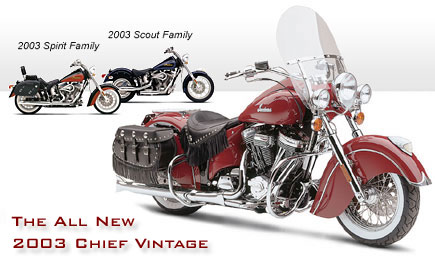
A decade later and here is the last of the Kings Mountain series Chiefs, 2013. (Note how it looks the same as the 2003 model, except for the paint scheme.) This is a very limited edition "Chief Vintage Final Edition", painted to recall the 1939 Chiefs and Scouts which were introduced at the Worlds Fair; also available black and white as smaller image below. As an investment , it might prove to have some appreciation in the future, but this is very hard to predict. ( Polaris Industries now owns Indian, and production has been moved to Medina, next to Minneapolis, Minnesota, USA.)
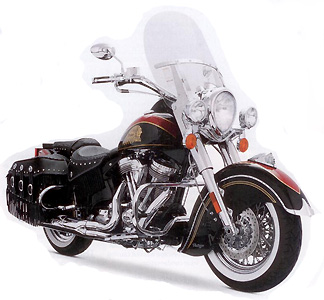
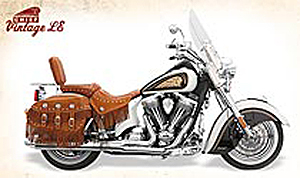
It should be added though that the "Gilroy" 1999-2003 Indians (actually about forty-five 2004 models were also made) were not as reliable as Harley or any other large V-twin. Riders frequently email me complaining of mechanical, electrical and brake problems, (not that I can help, please desist) and every magazine road test I read found its Chief with a flaw (e.g. leaking rear shock, leaking rear cylinder, chirping noise, gear shifting problems) and most found the brakes were reminiscent of a 1966 - 1971 era Harley (wooden and weak). Ironically, given the huge size and mass of sheet metal, handling (other than braking) was always found to be good for a heavy cruiser, better than many competitors.
Here are some photos I took in June 2014 of an all black 2009-13 Chief at the Orangeville (Ontario) Blues Festival. Note the multi-spoke custom wheels. Also a shot of a pretty two tone blue Chief at the CVMG annual rally in Paris (Canada) also in June 2014,
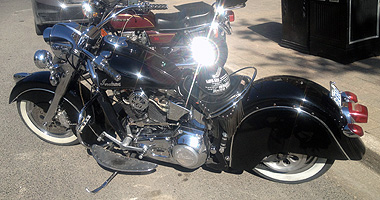
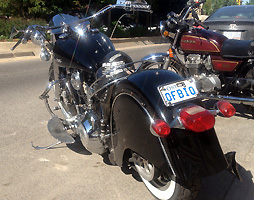
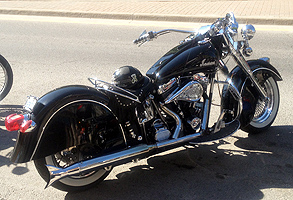
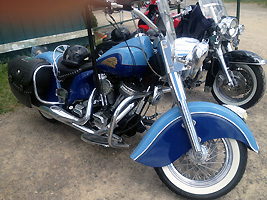
My own concerns about the 1999 - 2003 Gilroy Chiefs, most of which apply to
the very similar ones made at Kings Mountain up through 2013, (before Polaris
re-designed and greatly improved engineering and style) were:
1) excessive fork rake (more like a chopper and the gap between fender and
down-tubes looked far too much for a cruiser), however it looked fine on the
Scout models;
2) rear fender way too fat (and covering the rear brake creating potential for
overheating and fading under hard, repeated use);
3) the seat is all form and no function - thin, hard and stuck to the frame
like a home-made 1968 chopper;
4) there is an ugly cut away of the left front fender to clear the brake
caliper, again looking home-made and last-minute;
5) the front fender looks too narrow compared to the back (and vice versa).
The new front fender could've been made fat to match the rear by having the
sides cover the lower fork legs and brake, with hole in the top for the fork
tubes, which would also have solved the problem of cutting out the fender to
clear the brake;
6) rear drive is on left side and should be on right side to match original
Indians (not to mention Sportster, V-Rod, Ducati, 1990's up Triumphs, and
Victorys; happily 2014 models on have right side drive);
7) just like most Hawgs, the carb and air filter stick out so much it forces
you to curve your leg around it. No issue for rides of an hour or so but longer
distances creates potential for a cramped leg, like my 1980 Harley FLT tortured
me on a day long ride. A major ergonomic flaw.
(Some of these issues e.g. the ugly cutout for the front disk brake caliper, have been ameliorated since around 2010.)
Back in 2003 I test rode a Kawaski Drifter - a 1500 cc version - and found it felt light despite all the bulk (fenders aren't metal so that reduces weight), handled OK for a cruiser (terrible turning radius though, almost dangerously wide - no U-turns on single lane roads are possible), was very smooth, comfortable and surprisingly fast - found myself doing 165 kph (over 100 mph) with ease and still some twist left in the throttle. The Drifter was as reliable as a rock, so there was no feeling that this speed would cause a breakdown. Of course it had fuel injection. (3 small photos below show red Drifter 800 and two blue Drifter 1500s)
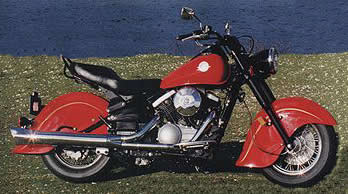
In 2005 I test rode a Kawaski 800 c.c. Drifter (the 1500's baby brother) and also found it a good machine. It was really an enjoyable ride except that on the highway the mill felt more like a 500 c.c. twin, i.e. buzzy and with very little reserve power, thus not suitable for touring or commuting on the expressway for more than half an hour. Also with the pseudo rigid rear frame and the rear fender swinging with the wheel you cannot mount saddlebags in the normal manner. However for anything less it was one of the best bikes I have ever ridden. I finally found out why the engine seemed so small on the highway. (Normally an 800 c.c. twin would be peppy.) The bike weighed 600 pounds when full of oil and fuel! This is very heavy for an 800 cc chain drive motorcycle. The weight must be the liquid cooling and internal engine balancers. Handling was amazing for such a heavy bike with fat tires. Felt as light as a 420 pound British twin. This Kaw was arguably a successor to the original Indian Scout. In comparison Kawasaki's 1600 Nomad felt like a whale, just too big and vague handling, with a very irritating huge gap beween 1st and 2nd gear, and a not very comfortable seating position. The Kaw 1500 Drifter ceased production with the 2004 model and the smaller 800 Drifter ended in 2005 or 2006 depending on what country. If the new Polaris series proves successful, one wonders if Kawasaki will revive their Drifters. (They revived their W650 British parallel twin imitation as an 800 when the current Triumph 865 twin became popular.) They say imitation is the best form of flattery.
Now getting back to the 1999- 2013 range of Indian V-twin motorcycles, as can be seen from the ad showing the 2003 range, in addition to the Chief there was the Spirit and Scout (that was the last year for them). (A road test of the Scout is available at the sister site to this one; click on "to the Scout site" on the handlebar at top of screen.)

Indian had many models and names for them over the years, but the Spirit was brand new as of 1999. As can be seen, the Spirit was basically a 1999 - 2003 Chief without the fender skirts and had a slightly less massive front end. Below is a 2003 tastefully customized and then a stock blue one with factory optional patriotic tank painting.

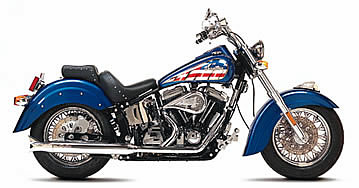
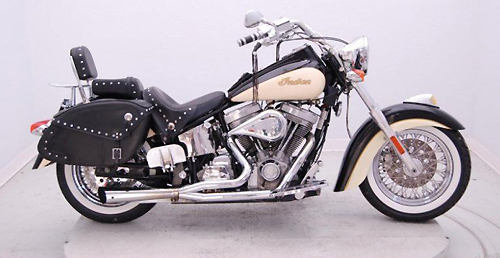
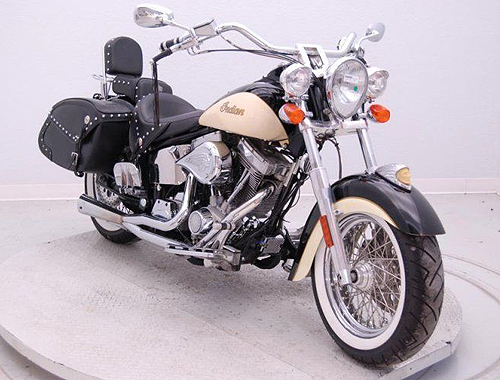
Spirit specs were:
Displacement 88 Cubic inch (1442 cc) Bore/Stroke 3.625 in. x 4.25 in.
Transmission Constant Mesh, Foot Shift, 5-Speed Carburetor S&S E Type, 1 7/8 in
bore / 47.6 mm Exhaust System 2 into 1 Primary Drive Chain Drive-Wet Clutch
Final Drive Aramid-reinforced Belt Dimensions & Weights Seat Height 28 in. / 711
mm Ground Clearance 5.75 in. / 146 mm Wheelbase 67 in. / 1702 mm Overall Length
99.5 in. / 2527 mm Overall Width 43.5 in. / 1105 mm Rake 32deg. Trail 5.25 in. /
133.4 mm Fuel Capacity 4.75 gallon U.S. / 18 litres(1.75 quarts / 1.65 litres
reserve) Oil Capacity 3.0 quarts / 2.8 liters w/filter Dry Weight 620 lbs. / 282
kgs. Wheels, Tires and Brakes Front Wheel 60 Spoke-Chrome, 3.5 in x 16 in Rear
Wheel 60 Spoke Chrome, 3.5 in x 16 in Front Tire 130/90-16 67H Rear Tire
130/90-16 73H Front Brake 4-Piston Caliper, Billet Aluminum Rear Brake 4 Piston
Caliper, Billet Aluminum General Instruments Analog Speedometer with odometer,
Proprietary bezel with V-shaped Indicator lights layout. Seat: Indian. Frame:
Indian. Front Suspension: 41mm Hydraulic Dual-dampening conventional style Rear
Suspension: Nitrogen charged Hydraulic absorber with adjustable pre-load. Colors
Black, Medium Silver Deluxe Colors Black/Red, Black/Silver, Black/Cream,
Red/Cream
The 2002 - 2013 POWER PLUS Engine
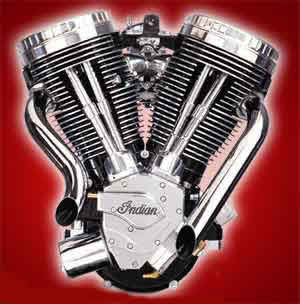
The original Indian V-2 engine was called the Big Twin. It only had seven (7) horspower. The Power Plus engine came out in 1916, to replace it. It was a 42 degree V-twin side-valver and had the same displacement as the older mill (61 cubic inches or 1 liter i.e. 1000 cc's). The Power Plus was a "power minus" weakling by today's standards, making only 17 horsepower but that was more than double the Big Twin's. The Chief was a new model bike introduced in 1922 using the Power Plus mill. The mill was enlarged to 74 CID (1200 c.c) in 1923 and the bike was renamed the Big Chief. This lasted until the next boost in engine size (via stroking) to 80 CID (1300 c.c.) in 1950. That only lasted for 4 production years (thru 1953). All those earlier Chief mills were side valve or flat head. The revived "Gilroy" Chief of 1999 had 88 CID or 1470 cc. That Power Plus was a 45 degree V-twin valve-in-head (OHV), pushrod operated, still with two valves per cylinder and still with air cooling, and instead of twin cams it had a single camshaft like the 1936 H-D Knucklehead (and later Panhead, Shovelhead and Evolution engines). This required very long pushrods at awkward angles to the rockers, unlike the earlier flathead engines of Indian and Harley (and Sportster) that had the cams push straight up. Basically the 1999 on Powerplus is a 1936 Harley Knucklehead design, (although the rocker covers give it a Panhead style) but much larger. It was enlarged in 2002 to 100 CID or 1640 cc. for the Chiefs and left at 88 inches for the Scouts and Spirits. Effective 2009 through 2013 it had 105 CID (1,720 c.c.), making it one of the largest V-twin engines ever made, and with fuel injection. The Gilroy (1999-2003) series had a Mikuni carburetor on the left side. Because of the chromed rocker covers (top of engine) ressembling old style twist off caps of soda pop bottles, this engine has become know as the "bottle cap" usually spelled as one word "Bottlecap".
Like all old American V-twins the 88, 100 and 105 inch Powerplus engines had a stroke longer than the bore which means lots of torque at low rpms for relaxed riding, and avoiding high rpms because they aren't available (and if they were the piston speed would be so high that destruction would occur). Even the all new Polaris built Chief will put out maximum power around only 5500 rpm. One reason Japanese sports bikes last is their stroke is so short they don't get up much piston speed, but of course this means you must use the high rpms to get any power, making for a relatively frantic riding experience more suitable to racing than legal speeds.
Following are a few shots of a mildly customized 2002 Chief kindly sent in by owner Col. Aaron Kenneston of Uncle Sam's army.

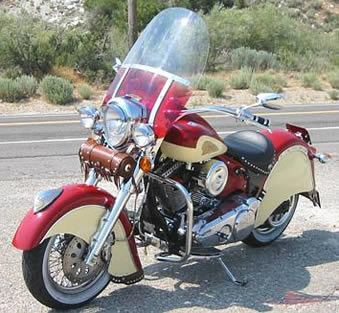
Here is a URL link to enjoy many more photos of Aaron's 2002 Chief. You can also see larger, sharper versions of the above photos there: link
In April 2011 the Polaris company, makers of fine snowmobiles and the Victory line of large, heavyweight, technologically advanced V-twin motorcycles bought out Indian. The 2012 and 2013 models looked just like the 1999-2011 ones. However, an all new 2014 model came out late in 2013. It looks more like the 1950-53 Chiefs in terms of engine and sheet metal but has a modern aluminium frame to reduce weight but even so weight is up to over 800 pounds. But engine displacement is about 500 cc greater than 1953, i.e. 1819 cc or 111 cubic inches. (see photo below).
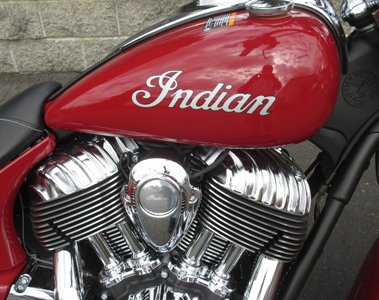

For 2014 there was no Spirit or Scout, just variations on the Chief, which makes sense as I found it "wrong" that the Scout and Spirit of the early 21st century (Gilroy) had the same big engine and frame as the Chiefs. For 2015 a new Scout was born with a completely different engine and displacment.- see SCOUT page of this site for photo. Below are two images of a 2015 Chief. Online and print medium tests including by Jay Leno are quite favorable, the sole exception being one tester reported a handling issue on freeway ramps.
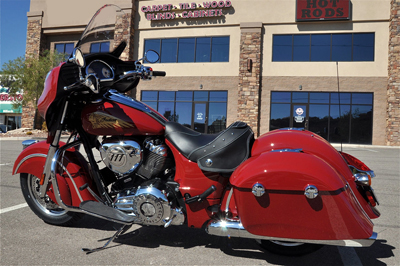
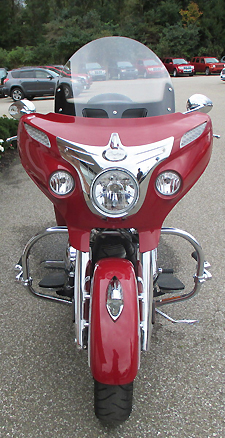
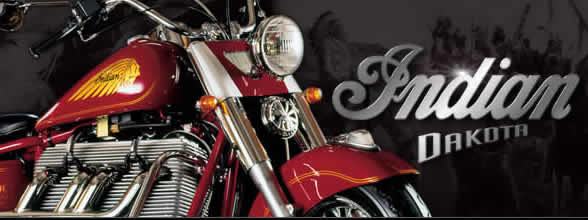
The Indian Dakota is or at least was a "Four" (4 cylinders in-line or "straight 4") with shaft drive, 5 speeds, disk brakes and electric starting. This machine was designed in Sweden as the Viking (see first photo below) and later refined and put on sale in Britain as the Dakota by a former punk rock star and biker Alan Forbes .This modern reincarnation of the fabled Indian Four has or at least had a Volvo car based engine (converted to air cooling and with performance enhancements) and the shaft drive is BMW. Volvo is Swedish and original Indian designer Oscar Hedstrom was from Sweden too, so the loop closes. Production of the Dakota began circa Y2K (around the year 2000). By "production" is meant built-to-order rather than mass-produced.
Image below is from Cycle World March 2000 issue.
The Dakota 4 received a very favorable road test review in Classic Bike magazine some years ago. It was available for sale in the USA for a few years; unknown if still available. The latest URL for the US website I had was www.dakota4.net was dated 2003 and showed a Fort Worth Texas contact, but that website is now defunct. While not designed nor made in the USA, legally the machine is a genuine Indian since it is a product of Indian Motorcycle Ltd., based in the UK (specifically Edinburgh, Scotland, Britain). That is a totally different entity than the Indian Motorcycle brand now owned in the rest of the world by the Polaris corporation of the USA. Maybe (hopefully) Polaris will become interested in the Dakota Four, in the same way the original Indian company bought the Ace Four in the 1930's and turned it into the famous Indian Four.
 |
 |
Here we see US Army Col. Kenneston touring London on an Indian Dakota 4 over a dozen years ago:
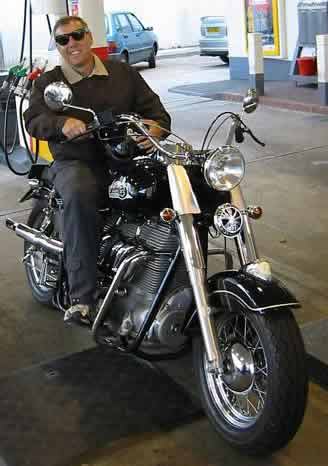
2011 / 2012 models below:

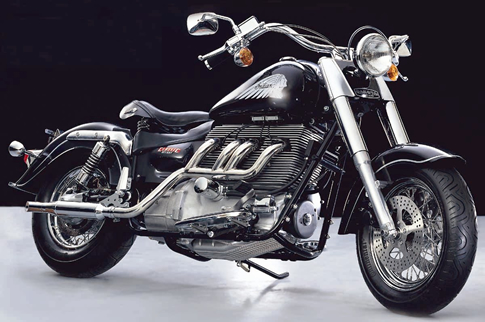
THANKS TO EVERYONE WHO HAS SENT PHOTOS OF THEIR INDIANS, STORIES, INFORMATION and CORRECTIONS. New material is always welcome and appreciated. If anyone recognizes their bike in this site please let me know so I can put your name in as owner. email author and web designer
This site is not the official site of the makers of the current lines of Indian motorcycles, (V twin Chiefs and Scouts) POLARIS INDUSTRIES.